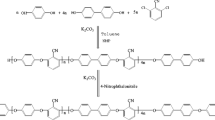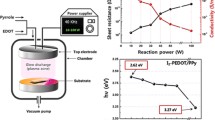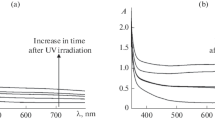Abstract
Fibrous polyethylene terephthalate (PET) was modified by organometallic vapor exposure to form hybrid materials with unique photoluminescent characteristics. Using a sequential vapor infiltration (SVI) process, the elongated exposures of trimethylaluminum (TMA) to PET were examined. As the infiltration temperature increased, the evidence of changes in the reaction between the organometallic vapor and the polymer was observed as well as significant changes in the infiltration depth into the polymer fiber, owing to the variation in the reaction mechanisms of the hybrid material formation. At TMA exposures of 60 °C, the mass of the polymer fiber increased by ∼55 wt%, whereas exposures at 150 °C were limited to ∼25 wt% infiltration. Photoluminescence analysis of PET after TMA infiltration shows an intensity increase of up to ∼13x and an increase in red shift with increasing infiltration temperature, attributed to the variations in the reaction mechanism to form the hybrid modification observed through the spectroscopy analysis.








Similar content being viewed by others
References
L.M. Bonanno and E. Segal: Nanostructured porous silicon-polymer-based hybrids: From biosensing to drug delivery. Nanomedicine 6(10), 1755 (2011).
J. Bouclé, P. Ravirajan, and J. Nelson: Hybrid polymer–metal oxide thin films for photovoltaic applications. J. Mater. Chem. 17(30), 3141 (2007).
C. Sanchez, B. Lebeau, F. Chaput, and J.P. Boilot: Optical properties of functional hybrid organic–inorganic nanocomposites. Adv. Mater. 15(23), 1969 (2003).
H. Floch and P. Belleville: A scratch-resistant single-layer antireflective coating by a low temperature sol-gel route. J. Sol-Gel Sci. Technol. 1(3), 293 (1994).
A. Wight and M. Davis: Design and preparation of organic-inorganic hybrid catalysts. Chem. Rev. 102(10), 3589 (2002).
M.H. Lim and A. Stein: Comparative studies of grafting and direct syntheses of inorganic-organic hybrid mesoporous materials. Chem. Mater. 11(11), 3285 (1999).
P. Judeinstein and C. Sanchez: Hybrid organic-inorganic materials: A land of multidisciplinarity. J. Mater. Chem. 6(4), 511 (1996).
B. Gong, Q. Peng, and G. Parsons: Conformal organic-inorganic hybrid network polymer thin films by molecular layer deposition using trimethylaluminum and glycidol. J. Phys. Chem. B 115(19), 5930 (2011).
B. Yoon, J. O’Patchen, D. Seghete, A. Cavanagh, and S. George: Molecular layer deposition of hybrid organic-inorganic polymer films using diethylzinc and ethylene glycol. Chem. Vap. Deposition 15(4–6), 112 (2009).
A. Dameron, D. Seghete, B. Burton, S. Davidson, A. Cavanagh, J. Bertrand, and S. George: Molecular layer deposition of alucone polymer films using trimethylaluminum and ethylene glycol. Chem. Mater. 20(10), 3315 (2008).
Y. Li, S. Mannen, J. Schulz, and J. Grunlan: Growth and fire protection behavior of POSS-based multilayer thin films. J. Mater. Chem. 21(9), 3060 (2011).
Y. Li, J. Schulz, S. Mannen, C. Delhom, B. Condon, S. Chang, M. Zammarano, and J. Grunlan: Flame retardant behavior of polyelectrolyte-clay thin film assemblies on cotton fabric. ACS Nano 4(6), 3325 (2010).
H.I. Akyildiz, R. Padbury, G.N. Parsons, and J.S. Jur: Temperature and exposure dependence of hybrid organic-inorganic layer formation by sequential vapor infiltration into polymer fibers. Langmuir 28(44), 15697 (2012).
B. Gong, Q. Peng, J.S. Jur, C.K. Devine, K. Lee, and G.N. Parsons: Sequential vapor infiltration of metal oxides into sacrificial polyester fibers: Shape replication and controlled porosity of microporous/mesoporous oxide monoliths. Chem. Mater. 23(15), 3476 (2011).
B. Gong, J.C. Spagnola, and G.N. Parsons: Hydrophilic mechanical buffer layers and stable hydrophilic finishes on polydimethylsiloxane using combined sequential vapor infiltration and atomic/molecular layer deposition. J. Vac. Sci. Technol. A 30(1), 01A156–1 (2012).
S-M. Lee, V. Ischenko, E. Pippel, A. Masic, O. Moutanabbir, P. Fratzl, and M. Knez: An alternative route towards metal-polymer hybrid materials prepared by vapor-phase processing. Adv. Funct. Mater. 21(16), 3047 (2011).
S-M. Lee, E. Pippel, U. Goesele, C. Dresbach, Y. Qin, C.V. Chandran, T. Braeuniger, G. Hause, and M. Knez: Greatly increased toughness of infiltrated spider silk. Science 324(5926), 488 (2009).
S-M. Lee, E. Pippel, O. Moutanabbir, I. Gunkel, T. Thurn-Albrecht, and M. Knez: Improved mechanical stability of dried collagen membrane after metal infiltration. ACS Appl. Mater. Interfaces 2(8), 2436 (2010).
Q. Peng, Y-C. Tseng, S.B. Darling, and J.W. Elam: A route to nanoscopic materials via sequential infiltration synthesis on block copolymer templates. ACS Nano 5(6), 4600 (2011).
Y-C. Tseng, Q. Peng, L.E. Ocola, D.A. Czaplewski, J.W. Elam, and S.B. Darling: Etch properties of resists modified by sequential infiltration synthesis. J. Vac. Sci. Technol., B: Microelectron. Nanometer Struct. 29(6), 06FG01 (2011).
Y-C. Tseng, Q. Peng, L.E. Ocola, J.W. Elam, and S.B. Darling: Enhanced block copolymer lithography using sequential infiltration synthesis. J. Phys. Chem. C 115(36), 17725 (2011).
C.A. Wilson, R.K. Grubbs, and S.M. George: Nucleation and growth during Al2O3 atomic layer deposition on polymers. Chem. Mater. 17(23), 5625 (2005).
J.S. Jur, J.C. Spagnola, K. Lee, B. Gong, Q. Peng, and G.N. Parsons: Temperature-dependent subsurface growth during atomic layer deposition on polypropylene and cellulose fibers. Langmuir 26(11), 8239 (2010).
Y. Sun, R.P. Padbury, H.I. Akyildiz, M.P. Goertz, J.A. Palmer, and J.S. Jur: Influence of subsurface hybrid material growth on the mechanical properties of atomic layer deposited thin films on polymers. Chem. Vap. Deposition 19(4–6), 134–141 (2013).
P. Poodt, A. Lankhorst, F. Roozeboom, K. Spee, D. Maas, and A. Vermeer: High-speed spatial atomic-layer deposition of aluminum oxide layers for solar cell passivation. Adv. Mater. 22(32), 3564 (2010).
Q. Peng, Y-C. Tseng, S.B. Darling, and J.W. Elam: Nanoscopic patterned materials with tunable dimensions via atomic layer deposition on block copolymers. Adv. Mater. 22(45), 5129 (2010).
D. Mary, M. Albertini, and C. Laurent: Understanding optical emissions from electrically stressed insulating polymers: Electroluminescence in poly (ethylene terephthalate) and poly (ethylene 2, 6-naphthalate) films. J. Phys. D: Appl. Phys. 30(2), 171 (1997).
G. Teyssedre, D. Mary, and C. Laurent: Analysis of the luminescence decay following excitation of polyethylene naphthalate films by an electric field. J. Phys. D: Appl. Phys. 31(3), 267 (1998).
Y. Kim, R. Davis, A. Cain, and J. Grunlan: Development of layer-by-layer assembled carbon nanofiber-filled coatings to reduce polyurethane foam flammability. Polymer 52(13), 2847 (2011).
Y. Takai, T. Mizutani, and M. Ieda: Photoluminescence study in polymers. Jpn. J. Appl. Phys. 17, 651 (1978).
G. Teyssedre, J. Menegotto, and C. Laurent: Temperature dependence of the photoluminescence in poly (ethylene terephthalate) films. Polymer 42(19), 8207 (2001).
J.C. Spagnola, B. Gong, S.A. Arvidson, J.S. Jur, S.A. Khan, and G.N. Parsons: Surface and sub-surface reactions during low temperature aluminium oxide atomic layer deposition on fiber-forming polymers. J. Mater. Chem. 20(20), 4213 (2010).
G.N. Parsons, S.E. Atanasov, E.C. Dandley, C.K. Devine, B. Gong, J.S. Jur, K. Lee, C.J. Oldham, Q. Peng, and J.C. Spagnola: Mechanisms and reactions during atomic layer deposition on polymers. Coord. Chem. Rev. 257(23), 3323 (2013).
P. Pullumbi, Y. Bouteiller, and L. Manceron: The vibrational spectrum of isolated AlH4−: An infrared matrix isolation and ab initio study. J. Chem. Phys. 101(5), 3610 (1994).
X. Wang, L. Andrews, S. Tam, M.E. DeRose, and M.E. Fajardo: Infrared spectra of aluminum hydrides in solid hydrogen: Al2H4 and Al2H6. J. Am. Chem. Soc. 125(30), 9218 (2003).
S-Y. Lin and Y-P. Lee: Infrared absorption of gaseous benzoyl radical C6H5CO recorded with a step-scan Fourier-transform spectrometer. J. Phys. Chem. A 116(24), 6366 (2012).
M.E. Jacox: The reaction of F atoms with acetaldehyde and ethylene oxide. Vibrational spectra of the CH3 CO and CH2CHO free radicals trapped in solid argon. Chem. Phys. 69(3), 407 (1982).
S. von Ahsen, H. Willner, and J.S. Francisco: Thermal decomposition of peroxy acetyl nitrate CHC (O) OONO. J. Chem. Phys. 121, 2048 (2004).
P.W. Bruckmann and H. Willner: Infrared spectroscopic study of peroxyacetyl nitrate (PAN) and its decomposition products. Environ. Sci. Technol. 17(6), 352 (1983).
B. Zhang, J. Zhang, and K. Liu: Imaging the “missing” bands in the resonance-enhanced multiphoton ionization detection of methyl radical. J. Chem. Phys. 122, 104310 (2005).
W.E. Thompson and M.E. Jacox: The infrared spectra of the NH-d cations trapped in solid neon. J. Chem. Phys. 114, 4846 (2001).
J.E. Johnson: X-ray diffraction studies of the crystallinity in polyethylene terephthalate. J. Appl. Polym. Sci. 2(5), 205 (1959).
R.d.P. Daubeny and C. Bunn: The crystal structure of polyethylene terephthalate. Proceedings of the royal society of London. Series A. Mathematical and Physical Sciences 226(1167), 531 (1954).
D.I. Bower: The Vibrational Spectroscopy of Polymers (Cambridge University Press, Cambridge, UK, 1992).
E.F. Archibong and A. St-Amant: Molecular structure of the AlO2 dimer, Al2O4. J. Phy Chem. A 102(34), 6877 (1998).
S. Kvisle and E. Rytter: Infrared matrix isolation spectroscopy of trimethylgallium, trimethylaluminium and triethylaluminium. Spectrochim. Acta, Part A 40(10), 939 (1984).
R. O’Brien and G. Ozin: A gas-phase Raman study of trimethylaluminium and trimethylboron monomers. J. Chem. Soc. A 1136 (1971).
J-R. Burie, A. Boussac, C. Boullais, G. Berger, T. Mattioli, C. Mioskowski, E. Nabedryk, and J. Breton: FTIR spectroscopy of UV-generated quinone radicals: evidence for an intramolecular hydrogen atom transfer in ubiquinone, naphthoquinone, and plastoquinone. J. Phy Chem. A 99(12), 4059 (1995).
ACKNOWLEDGMENTS
We would like to acknowledge Roberto Garcia from Analytical Instrumental Facility of North Carolina State University for his help for microtome. Authors also acknowledge partial funding from National Science Foundation Industry & University Cooperative Research Program: Center for Dielectrics and Piezoelectrics (CDP) (Grant No. 1361503), Army Competitive In-house Innovative Laboratory Research Grant, and Ministry of National Education of Republic of Turkey.
Author information
Authors and Affiliations
Corresponding author
Rights and permissions
About this article
Cite this article
Akyildiz, H.I., Lo, M., Dillon, E. et al. Formation of novel photoluminescent hybrid materials by sequential vapor infiltration into polyethylene terephthalate fibers. Journal of Materials Research 29, 2817–2826 (2014). https://doi.org/10.1557/jmr.2014.333
Received:
Accepted:
Published:
Issue Date:
DOI: https://doi.org/10.1557/jmr.2014.333




